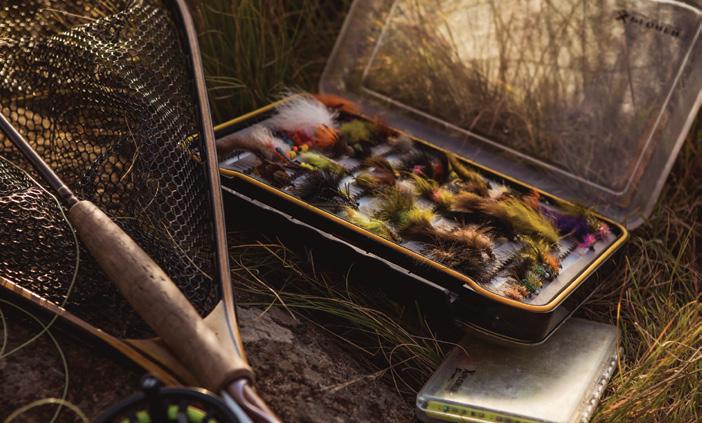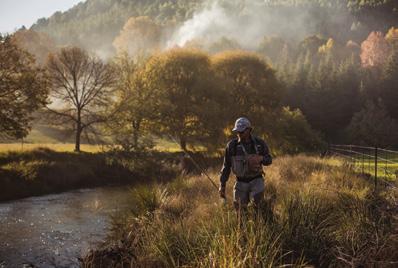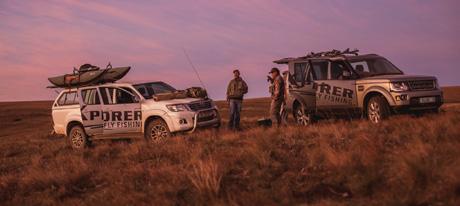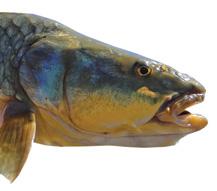
17 minute read
BEYOND TROUT
RECCIE BEYOND TROUT
THE MOUNTAINS OF THE WESTERN CAPE ARE HOME TO MANY TROUT STREAMS, BOTH WELL-KNOWN AND HIDDEN, OFFERING BOTH RAINBOWS AND BROWNS. BUT ONCE YOU HAVE QUENCHED YOUR THIRST FOR SALMONIDS, IF YOU PUSH DEEPER INTO THE MIDDLE OF NOWHERE AS LEONARD FLEMMING DID, YOU WILL FIND OTHER BIGGER, RARER, MORE-CHALLENGING SPECIES THAT HAVE BEEN AROUND THESE PARTS FOR A LOT LONGER
Photos. Leonard Flemming and Will Lotter
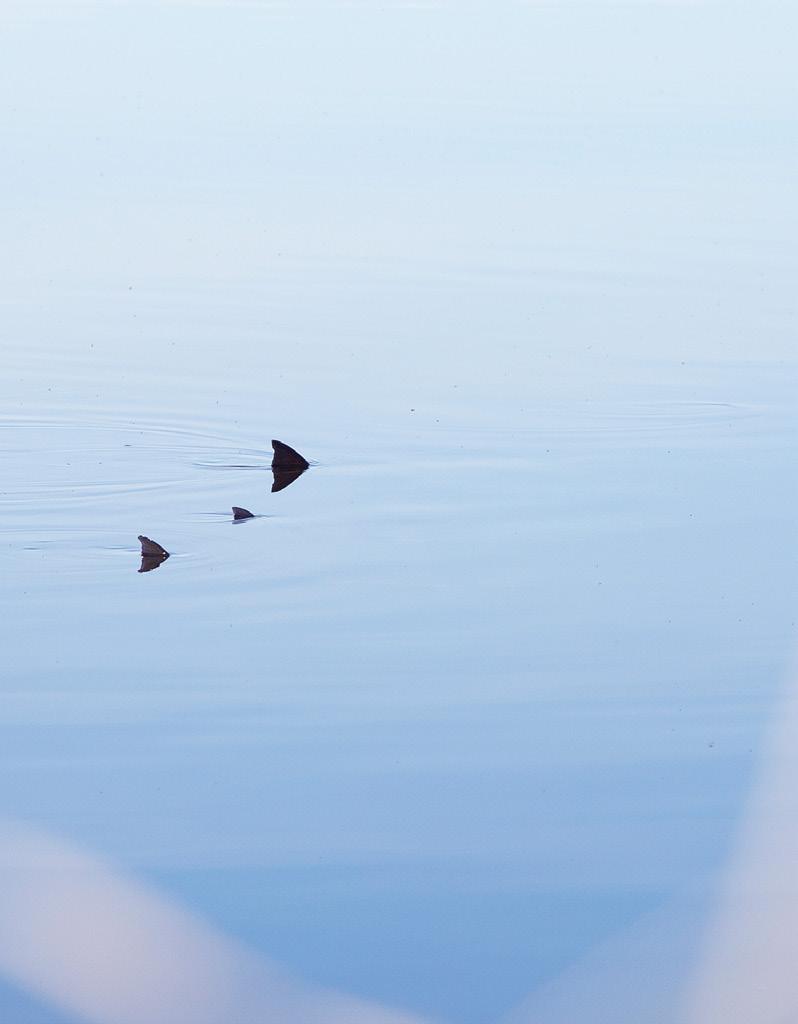

Throughout my life I’ve had an insatiable hunger for exploring Cape rivers. In Kleinmond, where I grew up, I’d disappear after school and scout along the banks of the tiny coastal streams for minnows, Cape stream frogs and water scorpions that would entertain me for hours.
This quickly became my church of preference and, I guess, like Charles Darwin, I started creating my own theories about animal relationships. I also learnt much about animal interactions which, as a kid, I noticed bore striking resemblances to human behaviour and the fine balances in life. For instance, I learnt that the death of an animal (which we generally perceive as sad or cruel) provided food for many organisms and even their offspring, a refreshing start to new life. In contrast, by closing one’s eyes at the mall, human noise sounded like the rival cacophony of baboon troops in the kloofs.
As a grownup, I still crave that sense of freedom and the urge to soak up the information that lies hidden in our mountainous environment, but with a fly rod in hand. It is in the presence of gurgling water, ferns growing lush under a canopy of red and white alders, exotic-looking birds like the Paradise flycatcher calling from the thickets, a large Table Mountain Beauty (aka the Aeropetes tulbaghia butterfly) pollinating red disas, that I find myself able to relax properly. All these things create a tranquil ambience while I stalk a cunning fish, as sipping insects are carried to it by the cool current. Here I can forget about the rat race. I get a chance to clear my mind and to digest the more important issues eating at my insides. I went through that familiar trout phase, when I hunted willing rainbows and wily brown trout in all the wellknown rivers as well as in any and every other river I’d heard rumours of. However, after about fifteen years of exploration, that trout stint came to an end when there were nearly no ‘new’ trout rivers to ‘find’. It was then that I encountered some of our larger indigenous fishes. I found big cyprinids, like witvis, by accident while searching for trout in the Breede River. It was the start of an unexpected and fascinating new journey, an educational fly fishing tour through the sporting arena of our indigenous fishes that would eventually take me to the final trout frontier. The invitation came from Craig Thom, the owner of the StreamX fly shop where I had been buying specialised micro-nymphing materials for witvis. He was talking about an exploratory mission with Duncan Brown, a professor at the University of the Western Cape and author of ‘Are Trout South African?’ to find remnants of salmonid stockings (other than rainbows and browns) and rumours of dry-fly-eating witvis in fabled fisheries that hadn’t seen angling traffic in more than 50 years.

I couldn’t believe my luck and, without thinking twice about the legality and legitimacy of access to the spots, I agreed to join the reconnaissance. It turned out that Duncan was participating in a global salmonid research project which, among other things, investigated the international distribution of trout and how they were perceived by humans in the different areas.
South African waters were stocked with rainbow trout, brown trout, Atlantic salmon, brook trout and tiger trout from the end of the 19th century throughout the 20th century. While rainbows and browns stuck and now enjoy a fanatical following of casual and competitive fly anglers, no wild brook trout have been recorded here since the 1960s. And, although involuntary stocking of Atlantic salmon took place on numerous occasions, even in the late 90s when 1000s of aquaculture fish escaped, none have been caught on fly in our country according to my knowledge. Tiger trout are sterile, of course, and their presence was shortlived.
So when you head out to fresh spots where you’ve never been and you know that few fisherman visit, there is that exciting element of surprise. Permits were issued for our contribution to the research we’d conduct with rods, lines and flies (still some of the best research tools for catching adult predatory fish) and off we went on a trip that would blow all of us away.
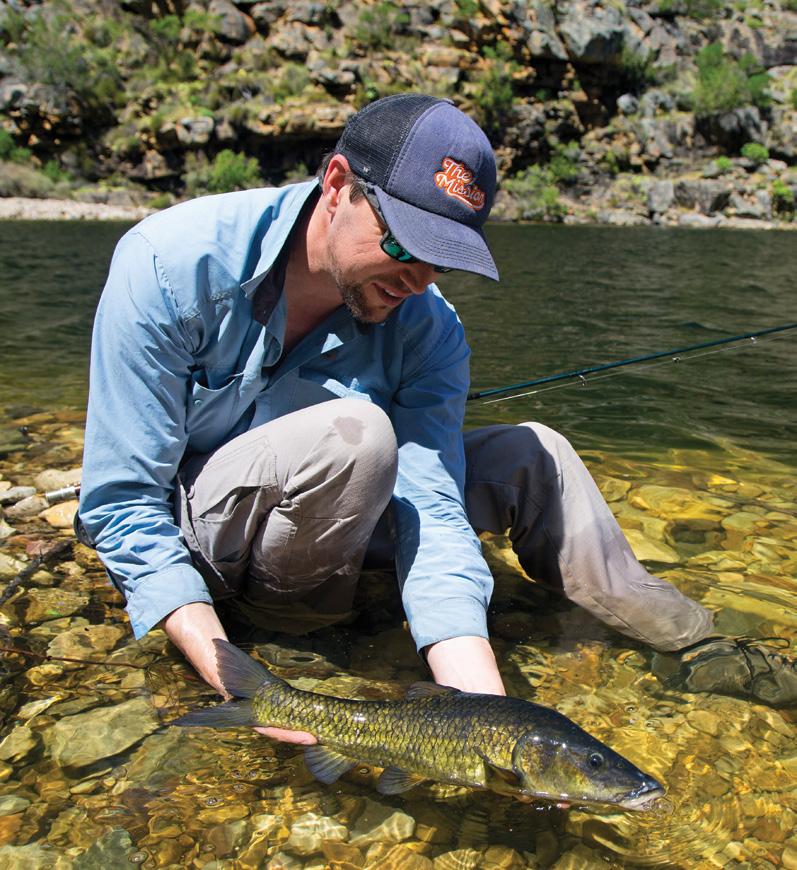
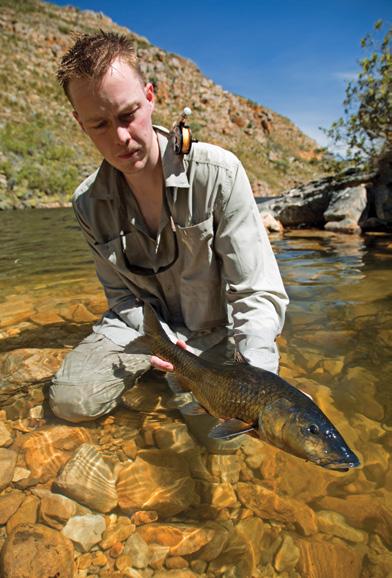
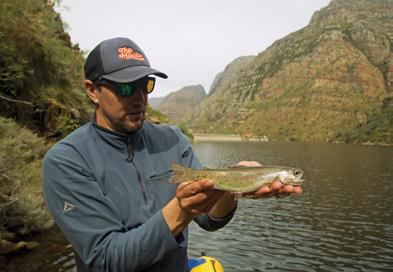
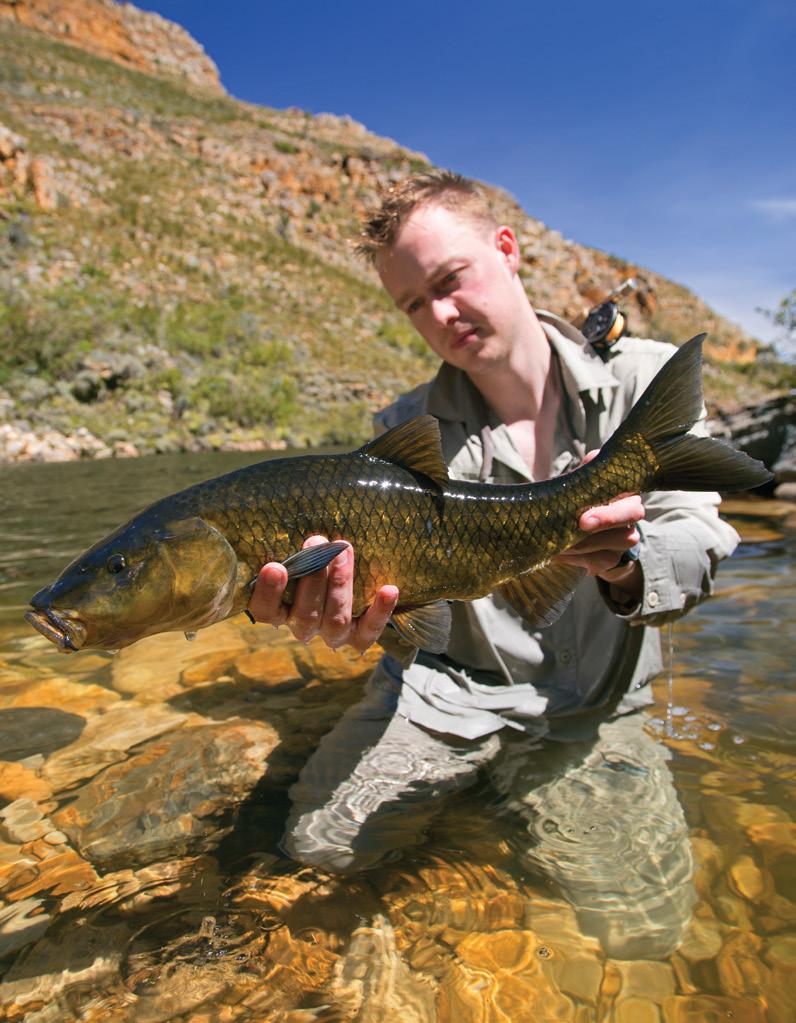
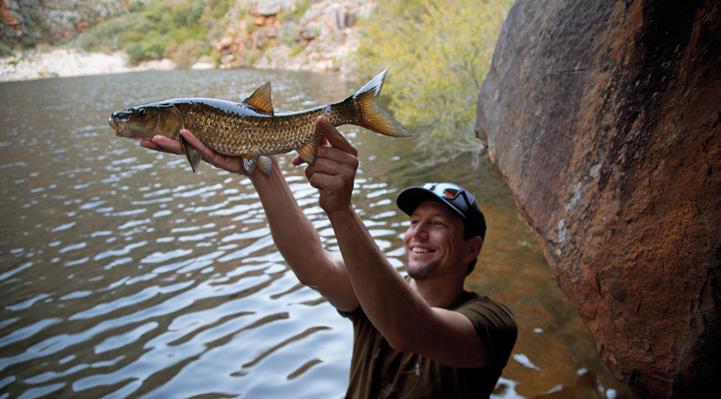
*Cue Lion King chorus* “Nants ingonyama bagithi Baba (Sithi uhm ingonyama) yeah, ingonyama.”
The recce missions often started with our having to lower our boats and outboards down steep walls and banks with climbing gear, just to reach the water. Luckily, I had anticipated difficult terrain and besides packing in tough hiking gear, I’d also, at the last minute, thrown in trad. climbing gear. Once on the water, we spotted bait balls of unidentified fish, gleaming turquoise, like giant pelagic sharks cruising near the surface in water more than 35 m deep. Human activity was so low in the catchment of the waters we sampled (which included five rivers, a dam and a plunge pool) that one could see the bottom six metres deep. The water was so clear that polarised sunglasses made schools of adult fish look like zeppelin squadrons gliding through the atmosphere. To our amazement, these lead-coloured zeppelins would also happily rise to eat dry flies and turned out to be trophy witvis. However, as usual, they showed great interest in micro nymphs. The most memorable fish for me was caught by William Lotter on a #20 flashback pheasant tail nymph. I was on spotting duty and noticed how a particularly large witvis approached Will’s dropper. The body language of the fish indicated that it had committed to eating the nymph and I gave Will the thumbs up to strike. Unsure of the situation, because the indicator hadn’t moved, he struck in slow-motion, clearly not expecting much. As the line tightened, the hooked witvis shot off into the deep gulley we were fishing and the little 2-weight reel screamed like a straining chainsaw moaning in the distance. Although Will was able to bring it back to the shallows, there were several heart-stopping moments when the fish tried to wrap the tippet around a submerged branch before we finally got a chance to scoop it into the landing net. In some instances, hooked fish simply couldn’t be stopped on the #20-26 flies, 7X tippet and 2-3-weight outfits we were forced to use to achieve the delicate presentations that were mostly required. I scrambled 300 metres along a steep bank after one such fish that eventually just cut the tippet on a rock shelf. It was unstoppable. Between the numerous lead zeppelins we also managed to catch a couple of rainbows each. They looked like sea trout; slender, silvery racing snakes one could imagine had freshly run up the river from the ocean. But the sea was far away and separated by many weirs and dam walls and kilometres of hectic temperature barriers and, perhaps, even dry river beds that would be the downfall of any salmonid trying to access this divine place. We later learnt, thanks to the micro-nymphs, that the big turquoise bait balls we spotted were massive schools of juvenile witvis roaming the open water.
When I got home, having been bedazzled by the beauty of these fisheries, I zoomed deeper into Google Earth than ever. The harder I searched for potential indigenous fish habitat, the more I realised how much water there was to explore. I searched for rivers and aquatic places on maps far beyond where I knew trout existed, and I traced waters that I believe fewer than a handful of adventurous fishermen have ever attempted to reach. Now I simply cannot wait to head out again to see what’s out there, beyond the final trout frontier.
NATAL SCALY ALWAYS CHOOSE SHARK
STARTING OUT IN FLY FISHING CAN BE TOUGH. CASTING, RIGGING, FLY SELECTION ETC. TO ‘GET’ FLY FISHING, SOMETIMES ALL IT TAKES IS 48 HOURS OF TOTAL IMMERSION, AS KATHRYN FOURIE FOUND WHEN SHE TOOK A DEEP DIVE INTO THE TUGELA RIVER AND ITS NATAL SCALIES AT A CLINIC AT ZINGELA CAMP
Photos. Kathryn Fourie
When my brother was turning 12, my Mom took me along to The Kingfisher tackle shop in Pietermaritzburg to buy some items for his birthday gift. My arty Mom, who worked in a law firm, had no idea what 12-year-olds require for fishing expeditions and, in the end, we walked out with what I thought was a pretty cool gift. I mean it was a hard, heavy, mini-baseball bat and I imagined all kinds of nefarious uses for it, like tadpole smashing to the max! My Dad, upon seeing the priest, promptly told my Mom to hand over the slip – and a day later came back with a packet bursting with colourful feathers, glues, clamps and all the cool stuff needed to tie flies. My early memories of fly fishing were watching my brother casting on the mowed lawn, or his skinny frame hunched over his fly-tying station or being taken along on day trips to Kamberg and Crystal Waters, where I would disappear and swim in the rivers and pretend, no doubt, that I was the lone survivor of some kind of dinosaur annihilation. Meanwhile, my Dad and brother silently got their fish on. Twenty-eight years on from those memories and I am racing towards forty. Instead of feeling like I need to be achieving more, going further, growing up, all I can think about is doing less. I stare at the pictures in fishing magazines, my thumb hovers over posts about wild salmon fishing in Alaska. When I was sent an e-flyer for a beginner fly fishing intro weekend hosted by Wildflower Adventures, it took me about 24 seconds to make up my mind. Maybe fewer. So it was that I wound up buying a second-hand fly fishing rig and found myself casting off the banks of the Tugela River at Zingela Safari and River Company… at the completely wrong time of the year for catching yellows. This may sound kind of daft, but for the entirely uninitiated fly fisher, a weekend of low fish-catching expectations was ideal. Our group of ten could focus on learning the absolute basics of Figure 8’s and Rapala knots, without the niggling feeling that we were missing out on prime catching conditions.
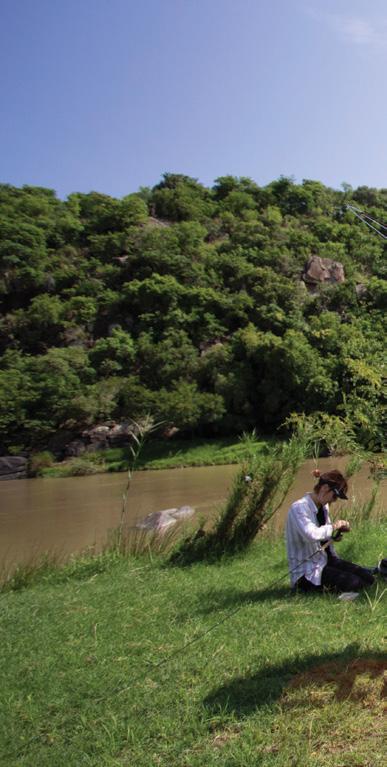
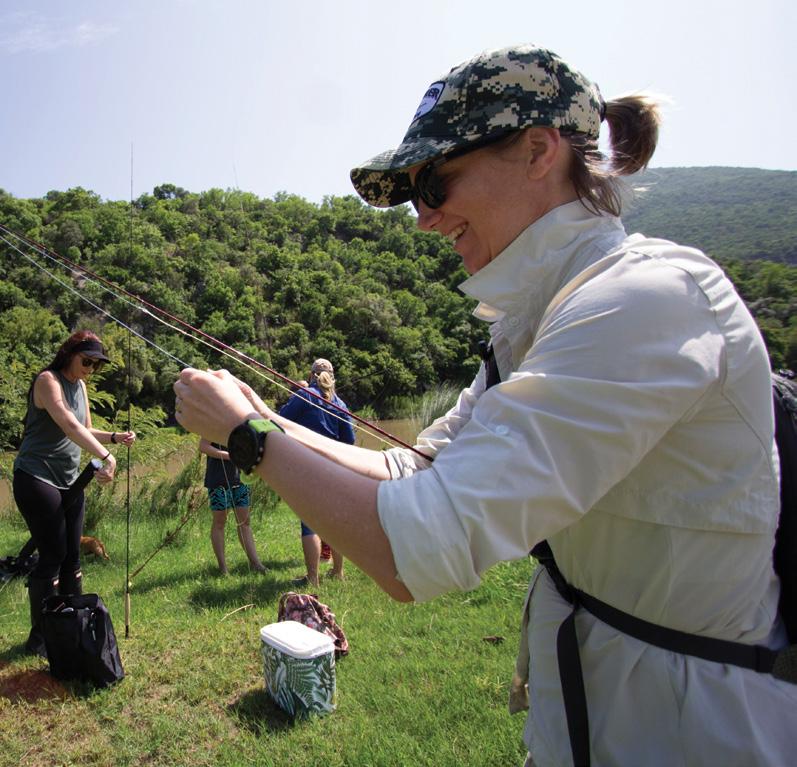
Kirsty Kyle was the fly-fishing expert imported from the Natal North Coast to guide us to a reasonable state of fishing ability. The humble Kirsty was tutored in fishing by her parents and two older brothers in the wilds of Kosi Bay. She grew up home-schooled and has a way that I envy with animals (especially the types that have cold blood). On day one she found a Rhombic Egg Eater and held the spiraling serpent in her hand while we clutched cups of coffee, mesmerised by the hallucinogenic effect of its defensive behaviour. Having learnt that she is actually a proper herpetologist does, in part, explain her ability to commune with the scaliest and slipperiest of the bushveld beasts! These are not in short supply at Zingela. Kirsty cleverly devised some easy-to-use tools to teach us knots (stretches of nylon rope), effectively supersizing line so that we could see the patterns quickly. It didn’t take long to tie tippet to line, and we were sent on to the lawns with paintbrushes, plastic bags and small jars of paint to practise the wrist movements involved with casting.
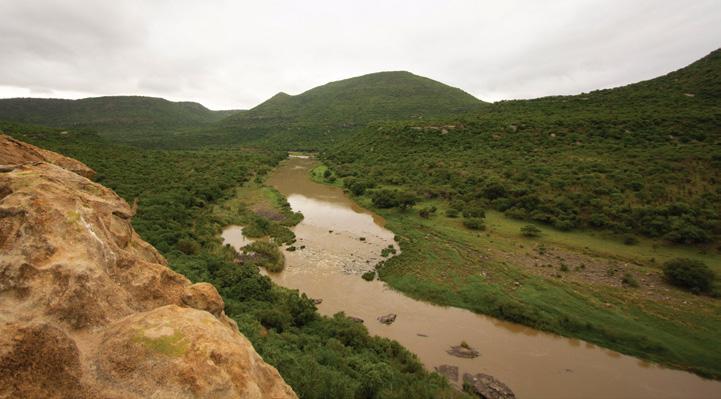
I had no clue we’d be Jackson Pollocking the riverine vegetation outside the deck at the main Zingela dining area, but with blue, green, orange and pink all over the show, we had the motion down pretty well. After casting on open stretches of lawn, fast forward a few hours into the afternoon and we were ready to hit the river. And hit it we did. Unfortunately for me, that hitting involved catching a lot of grass and one cast in particular whipped into my Buff just near my eyebrow. Anti-Covid protection became injury prevention. After my third wobble into the river to release my Hot Spot from under a rock and just before a total optimism meltdown, Kath Calverly arrived with a cooler box crammed with G&T supplies. And, amazingly, Lee-Ann caught a small yellow, almost effortlessly. We cheered…and doubled down on our individual efforts. Maybe catching was possible after all. At supper that night whisperings of a large ingwenya (crocodile) that had been sighted on stretches of the river up and down from the camp started to circulate. It was no longer a ‘maybe’. A sizeable crocodile was definitely in the area and in the brown water of summer it had ideal hunting conditions. It was decided that we would fish quite far north of the camp on Sunday, as the last spotting was cited to be close to camp. At Zingela one can’t help but feel completely hidden in a separate, timeless world of African acacias, tamboti trees, aloes, animals, sounds and vibrations. Falling asleep under thatch, frogs singing away, soggy shoes and rods ready at the door for go-time, it is almost effortless to forget about things that create anxiety in one’s life only an hour’s 4x4 drive out of the valley. Perspectives shift here: I can tie knots, I can figure out fishing. Sunday dawns as an absoluter cracker, a quintessential South African summer day. Sunscreen is slapped on; and we move quickly on a short walk high up the valley sides to look down on the river where we’ll be fishing. Eyes are peeled for the sneaky croc – but no sighting so we feel reassured it’s headed south. Bibi shuttles our crew in an open 4x4 to the fishing spot and ten eager pairs of hands grab kit and we hustle across granite-grey, rounded rocks and shale substrate to reach the riverbank. The friendly banter stops as concentration efforts increase, tying flies to tippet again, this time with confidence. People are making tweaks based on yesterday’s experience and in no time at all the only sounds are birds, the river and the gentle ‘zzzzzzzzzzz’ of lines casting back and forth through the air. Lee-Ann catches again! Heads turn towards her – thumbs up – but no-one is running to look at the fish this time. The game is on. We all want one to hold, to unhook and to send back to the depths of the Tugela. But the river has other plans for us and 45 minutes later I am wondering if it’s the sinking line which is foiling me. Maybe it’s my cast? Shit. I decide to try another area where Kirsty and Kath have actually made their way across the river. It is deeper than I expect, chest deep in fact. A couple of us make the crossing and the fishing is far easier standing on a wide-
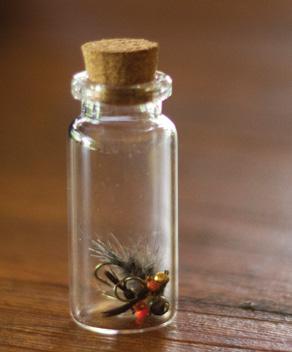
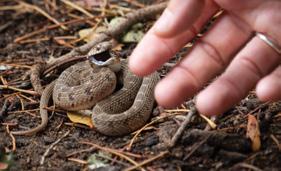
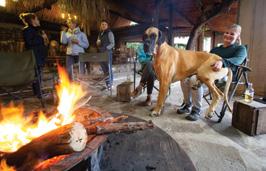


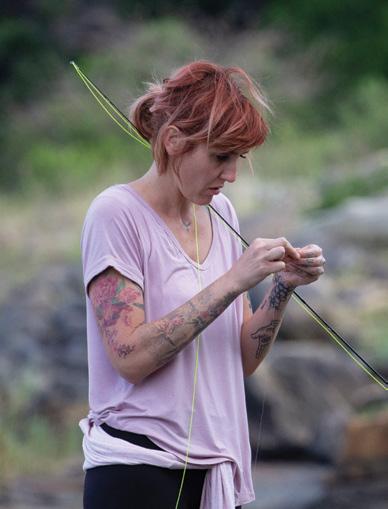

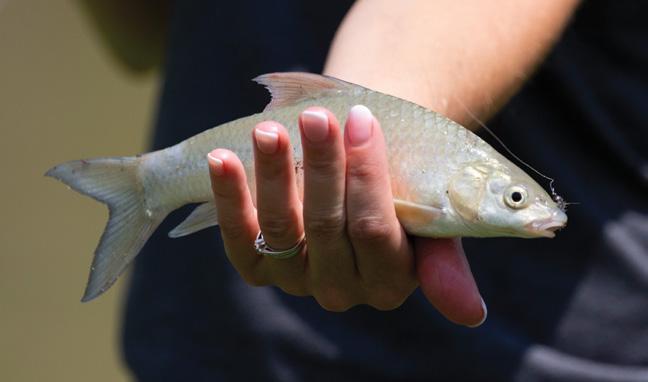
Angler of the weekend, Lee-Ann Driemeyer, with a fin-perfect juvenile Natal Scaly.
open band of shale. But time runs out and we have to head back. I have lost count of Lee-Ann’s catches. She’s the only one winning here so she is doing something right! For some reason, crossing back over the river is not as easy. I lose my footing, the current is strong, and I am completely submerged holding my rod up and laughing, kicking my feet in takkies to get across. This happens to at least five of us, but no one cares. It’s hot and this is refreshing. Sitting back at the dining area demolishing breakfast and coffee, my Dad who has also come along for the weekend to walk and twitch with his friend, comes to join us. “Did you guys see the croc?” “No Dad, but it’s a good thing, as we were neck deep in the water”, I laugh in reply. “No, I mean, I am asking if you saw it because we saw it. Just after you passed us on the 4x4 this morning near where you got off. We actually thought we’d catch a lift back so we waited for Bibi to return and, when getting on the vehicle, we had the extra height and we saw it right there on the bank in the sun. It was huge. Three metres long at least, and thick like this.” He holds his hands out indicating a body size that is rather alarming… at least twice my size. “And then it slid back into the water and we couldn’t see it”.
One of the questions I have asked myself since I was old enough to watch nature programmes was, “Would I rather die by crocodile or by shark attack?” My well thought out debate has always led me to think a shark would be better. I choose shark every time. I had such a great time standing waist-deep in the cool waters of the river, concentrating on catching small life forms to release, that I had completely forgotten about that predatory life form that would undoubtedly not have wanted to release me. But what you don’t know doesn’t hurt you and while we broke down our rods, discussed what pieces of kit we needed going forward and loaded up to leave, we appreciated that Kirsty had done her job. For the most part, we knew what we were doing and we wanted more of it. Wild Flower Adventures had set up exactly the right approach for a bunch of fly fishing dreamers. No question was considered stupid, no matter how many times it was asked. Evidence of the ‘mission accomplished’ was the Whatsapp group formed in the following weeks, flooded with pictures of our group members out fishing with their daughters, their friends, holding up trout, more yellows, carp…even a frog (not sure that was entirely legal though). We’re planning a reunion trip in late May or early September. And yes, the big ol’ croc, after a flooded Tugela summer, has long since moved. To find out more about Wildflower Adventures fishing camps for 2021, contact Kat Calverly on kat wildfloweradventures@gmail.com
